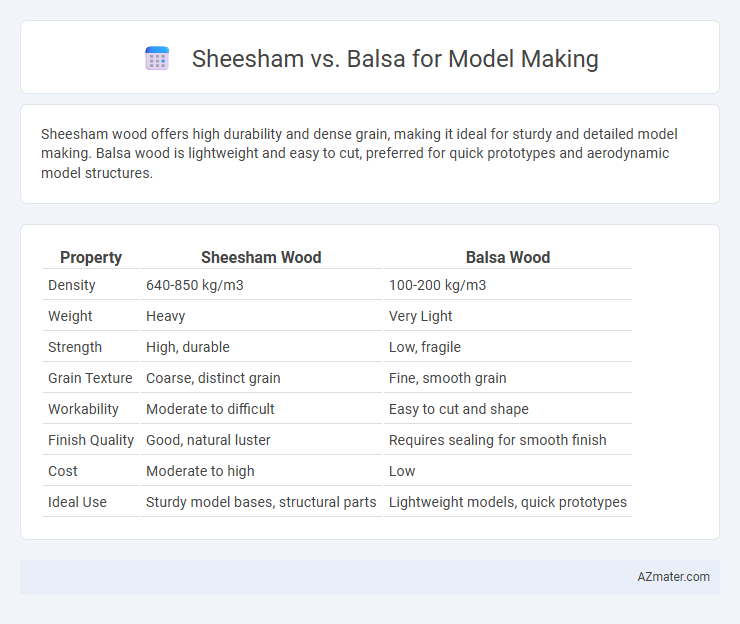Sheesham wood offers high durability and dense grain, making it ideal for sturdy and detailed model making. Balsa wood is lightweight and easy to cut, preferred for quick prototypes and aerodynamic model structures.
Table of Comparison
| Property | Sheesham Wood | Balsa Wood |
|---|---|---|
| Density | 640-850 kg/m3 | 100-200 kg/m3 |
| Weight | Heavy | Very Light |
| Strength | High, durable | Low, fragile |
| Grain Texture | Coarse, distinct grain | Fine, smooth grain |
| Workability | Moderate to difficult | Easy to cut and shape |
| Finish Quality | Good, natural luster | Requires sealing for smooth finish |
| Cost | Moderate to high | Low |
| Ideal Use | Sturdy model bases, structural parts | Lightweight models, quick prototypes |
Introduction to Sheesham and Balsa Woods
Sheesham wood, also known as Indian Rosewood, is a hardwood prized for its durability, rich brown color, and natural resistance to decay, making it ideal for detailed and long-lasting model making projects. Balsa wood, on the other hand, is an exceptionally lightweight and soft wood frequently used in model building due to its ease of cutting and shaping, despite being less durable than hardwoods like Sheesham. The choice between Sheesham and Balsa depends on the model's structural requirements and desired finish quality, with Sheesham suited for sturdier models and Balsa favored for lightweight, delicate designs.
Wood Properties: Density and Weight Comparison
Sheesham wood has a density of approximately 800 kg/m3, making it significantly heavier and more durable compared to balsa, which has a density of around 160 kg/m3. The low density of balsa wood results in an extremely lightweight material ideal for model making where ease of handling and minimal weight are critical. Sheesham's higher density provides greater strength and resistance to damage but may add unnecessary weight for precise, delicate models.
Strength and Durability: Sheesham vs Balsa
Sheesham wood offers significantly higher strength and durability compared to balsa, making it ideal for model structures requiring robust support and long-lasting performance. Balsa's lightweight and softness provide ease of shaping but result in lower strength and susceptibility to damage under stress or moisture exposure. For projects demanding structural integrity and prolonged durability, Sheesham is the superior choice, while balsa suits lightweight, less load-bearing models.
Workability and Ease of Cutting
Sheesham wood offers a dense, durable texture that requires sharper tools and more effort for cutting, providing a sturdy finish ideal for detailed model making. Balsa wood stands out for its exceptional workability and ease of cutting due to its lightweight, soft grain, allowing precision and quick shaping with minimal resistance. Model makers often prefer Balsa for rapid prototyping, while Sheesham suits projects requiring strength and finer carving detail.
Surface Finish and Detailing Potential
Sheesham wood offers a smooth surface finish with natural grain patterns that enhance detailed model making, providing durability and fine textural contrast ideal for intricate carvings. Balsa, known for its lightweight and soft texture, allows for easy carving and precise detailing but tends to have a rougher surface that may require additional sanding or finishing to achieve a polished look. For high-detail models requiring a refined finish, Sheesham is preferable, whereas Balsa suits projects prioritizing ease of shaping over surface smoothness.
Cost Efficiency and Availability
Sheesham wood offers greater durability and a richer grain, making it slightly more expensive but long-lasting for intricate model making projects. Balsa wood, known for its lightweight and easy to cut properties, provides superior cost efficiency and is widely available in most craft stores. For budget-conscious model makers prioritizing quick, straightforward work, balsa is often the more accessible and affordable choice.
Suitability for Different Model Types
Sheesham wood, known for its density and durability, is ideal for detailed and structural model making such as architectural models, ship models, and intricate sculptures that require strength and fine grain for precision carving. Balsa wood, being lightweight and soft, is suited for aerodynamic model types like airplane prototypes, gliders, and lightweight frameworks where ease of cutting and minimal weight are critical. Choosing between Sheesham and Balsa depends on the model's functional requirements; Sheesham provides robustness and fine details, while Balsa offers flexibility and lightness for flight or minimalist designs.
Environmental Impact and Sustainability
Sheesham wood, known for its dense grain and durability, is sourced from slow-growing trees, raising concerns about deforestation and longer regeneration periods compared to Balsa, which is fast-growing and renewable. Balsa's lightweight nature and rapid growth cycle contribute to a lower environmental impact and higher sustainability in model making. Prioritizing Balsa over Sheesham can significantly reduce ecological footprints and support sustainable forestry practices.
User Experiences and Expert Opinions
Sheesham wood offers superior durability and a rich grain pattern, highly favored by expert model makers for intricate detailing and long-lasting projects. Balsa wood is praised by users for its lightweight and ease of cutting, making it ideal for prototypes and quick iterations, though it lacks the strength of Sheesham. Experts often recommend Sheesham for structural components and aesthetic appeal, while Balsa remains the preferred choice for rapid development and ease of manipulation.
Verdict: Choosing the Right Wood for Your Model
Sheesham and Balsa differ significantly in density and workability, impacting their suitability for model making. Sheesham offers strength and durability, making it ideal for models requiring structural integrity, while Balsa's lightweight and easy-to-carve nature favor delicate, detailed projects. Choosing the right wood depends on balancing durability needs with ease of shaping and weight constraints specific to your model design.

Infographic: Sheesham vs Balsa for Model Making
 azmater.com
azmater.com